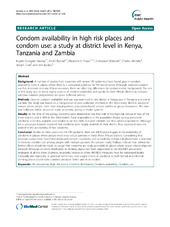Condom availability in high risk places and condom use: a study at district level in Kenya, Tanzania and Zambia
| dc.contributor.author | Sandøy, Ingvild Fossgard | en_US |
| dc.contributor.author | Blystad, Astrid | en_US |
| dc.contributor.author | Shayo, Elizabeth H. | en_US |
| dc.contributor.author | Makundi, Emmanuel | en_US |
| dc.contributor.author | Michelo, Charles Cheembo | en_US |
| dc.contributor.author | Zulu, Joseph | en_US |
| dc.contributor.author | Byskov, Jens | en_US |
| dc.date.accessioned | 2013-05-16T10:25:22Z | |
| dc.date.available | 2013-05-16T10:25:22Z | |
| dc.date.issued | 2012-11-26 | eng |
| dc.Published | BMC Public Health 2012, 12:1030 | eng |
| dc.identifier.issn | 1471-2458 | |
| dc.identifier.uri | https://hdl.handle.net/1956/6619 | |
| dc.description.abstract | Background: A number of studies from countries with severe HIV epidemics have found gaps in condom availability, even in places where there is a substantial potential for HIV transmission. Although reported condom use has increased in many African countries, there are often big differences by socioeconomic background. The aim of this study was to assess equity aspects of condom availability and uptake in three African districts to evaluate whether condom programmes are given sufficient priority. Methods: Data on condom availability and use was examined in one district in Kenya, one in Tanzania and one in Zambia. The study was based on a triangulation of data collection methods in the three study districts: surveys in venues where people meet new sexual partners, population-based surveys and focus group discussions. The data was collected within an overall study on priority setting in health systems. Results: At the time of the survey, condoms were observed in less than half of the high risk venues in two of the three districts and in 60% in the third district. Rural respondents in the population-based surveys perceived condoms to be less available and tended to be less likely to report condom use than urban respondents. Although focus group participants reported that condoms were largely available in their district, they expressed concerns related to the accessibility of free condoms. Conclusion: As late as thirty years into the HIV epidemic there are still important gaps in the availability of condoms in places where people meet new sexual partners in these three African districts. Considering that previous studies have found that improved condom availability and accessibility in high risk places have a potential to increase condom use among people with multiple partners, the present study findings indicate that substantial further efforts should be made to secure that condoms are easily accessible in places where sexual relationships are initiated. Although condom distribution in drinking places has been pinpointed in the HIV/AIDS prevention strategies of all the three countries, its priority relative to other HIV/AIDS measures must be reassessed locally, nationally and regionally. In practical terms very clear supply chains of condoms to both formal and informal drinking places could make condom provision better and more reliable. | en_US |
| dc.language.iso | eng | eng |
| dc.publisher | BioMed Central | eng |
| dc.rights | Attribution CC BY | eng |
| dc.rights.uri | http://creativecommons.org/licenses/by/2.0 | eng |
| dc.subject | HIV prevention | eng |
| dc.subject | High risk places | eng |
| dc.subject | Condom distribution | eng |
| dc.subject | Condom use | eng |
| dc.subject | Condom availability | eng |
| dc.title | Condom availability in high risk places and condom use: a study at district level in Kenya, Tanzania and Zambia | en_US |
| dc.type | Peer reviewed | |
| dc.type | Journal article | |
| dc.description.version | publishedVersion | en_US |
| dc.rights.holder | Copyright 2012 Sandøy et al.; licensee BioMed Central Ltd. | |
| dc.source.articlenumber | 1030 | |
| dc.identifier.doi | https://doi.org/10.1186/1471-2458-12-1030 | |
| dc.identifier.cristin | 995782 | |
| dc.source.journal | BMC Public Health | |
| dc.source.40 | 12 |

